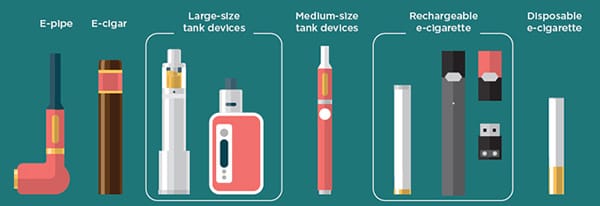The teen vaping epidemic

By Daniel Williams; photo courtesy of www.cdc.gov
Vaping among teens has reached the epidemic stage, according to national statistics as well as local narratives.
At a recent Douglas County sporting event that brought together competitors from several of the area’s high schools, I spoke with parents and student-athletes alike who all agreed that vaping is a major problem at their school. No one wanted to talk on record, but plenty of parents and students were willing to discuss the issue.
“When I take my daughter to school,” said one of the parents, “I’ll be stuck in traffic and look to the other cars and see students with this giant cloud of smoke surrounding them.”
“That’s not the only place students vape,” said one student-athlete. According to the student, kids are vaping on their way to school, in the parking lot, in bathrooms, even in the classrooms during class.
“That can’t be true,” I said.
“It is,” another student said. “Students will open their text book and duck their head and vape into the book and then wave away the cloud real fast.”
“Where’s the teacher?” I asked.
“The teacher will be writing on the board or looking something up on the computer while the student vapes.”
“Do the kids get in trouble?” I asked.
The group of students looked at one another and nervously giggled. Then one of them said: “When they get caught.”
Recent vaping data
A November 2018 report from the U.S. Food and Drug Administration revealed that vaping among high school students nationwide increased roughly 80 percent in the past year and increased 50 percent among middle school students in that same timeframe.
The news is even worse close to home. According to a recent behavioral risk survey from the Centers for Disease Control and Prevention (CDC), high schoolers in Colorado are using e-cigarettes or other vaping products at twice the national average. The CDC study found that 26 percent of Colorado high schoolers use vaping products.
“To lead the nation in youth vaping is intolerable,” said Governor John Hickenlooper at a November 2 press conference at Children’s Hospital Colorado, where he signed an executive order to address the vaping epidemic. “Collectively, we can help ensure families better understand the lifetime health impact of vaping at a young age and work to decrease the number of youths turning to this popular, yet problematic form of nicotine.”
The executive order outlined several steps Colorado will take to curb vaping use, including:
– Directing the Department of Revenue to double its compliance checks of tobacco and e-cigarettes to ensure they are not selling to underage buyers. (Currently, consumers 18 years old can purchase vaping products, though Hickenlooper and many health officials would like to see that number raised to 21 years of age.)
– Extending the current prohibition on smoking in state buildings to e-cigarettes and vaping. It also extends prohibitions on smoking and vaping to the grounds of state buildings, not just the buildings themselves (i.e. it creates smoke free campuses).
– Requiring the Colorado Department of Public Health and Environment to begin conducting research between vaping and some of the other risky behaviors seen in kids.
According to Tista Ghosh, MD, interim chief medical officer for the Colorado Department of Public Health and Environment, vaping can “lead to nicotine addiction, and can be associated with other risky behaviors that can affect a teen’s health. Our state data shows that teens who vape are more likely to use alcohol, drugs and engage in risky sexual behaviors.”
When I mentioned this information to the group of Douglas County student-athletes, they all nodded their heads in agreement and then one of them stepped forward.
“The really scary thing about vaping is we don’t know the long-term effects,” said the student, who has plans for a career in medicine. “People smoked regular cigarettes for a long time before the studies came out about lung cancer and other health issues. Until then, how do we really know what the impact of vaping will be long-term? We don’t.”
Parents wanting to know more about how to help educate their kids about the dangers of tobacco and other nicotine products can visit teen.smokefree.gov.
Facts and information about e-cigarettes and vaping
An e-cigarette is a battery-operated device that emits doses of vaporized nicotine or non-nicotine solutions for the user to inhale. It can resemble a cigarette, cigar, pipe or a pen.
E-cigarettes were first marketed as a way to stop or reduce smoking traditional tobacco cigarettes.
The solution in many vaping products is known as e-liquid or e-juice and is made by extracting nicotine from tobacco and mixing it with a base, usually propylene glycol and flavoring.
Using an e-cigarette is sometimes called “vaping” or JUULing.”
JUUL is a brand of e-cigarette that can be shaped like a USB flash drive.
A single JUUL pod contains as much nicotine as a pack of 20 regular cigarettes.
Scientists are still learning about the long-term health effects of e-cigarettes.
Sources: Centers for Disease Control and Prevention, U.S. National Health Department